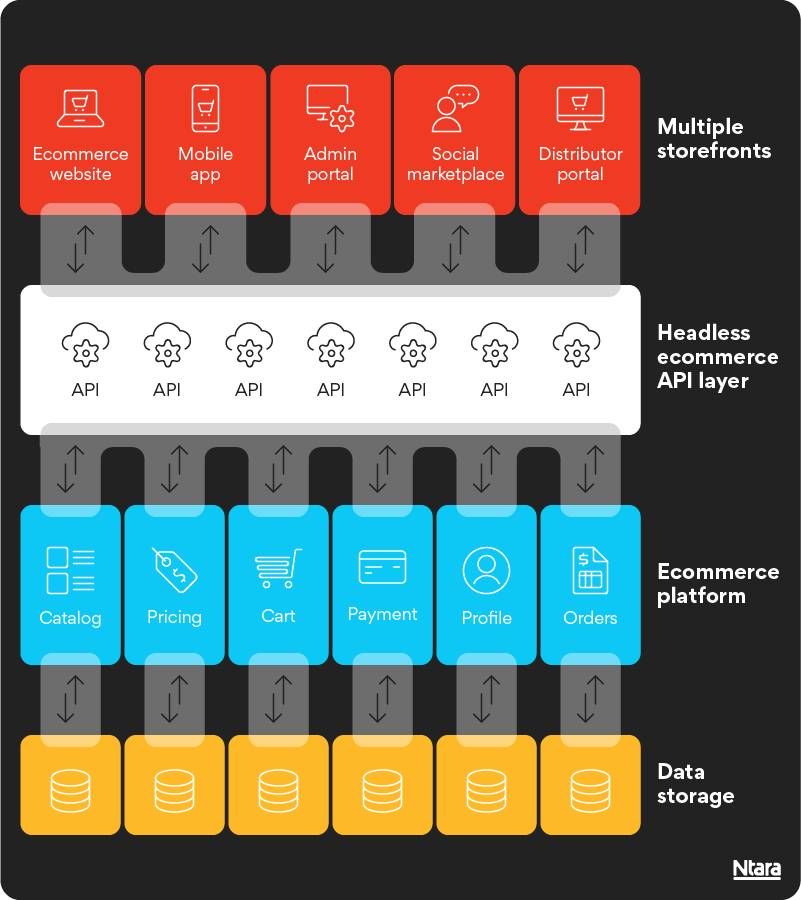Simply put, “headless” means platform agnostic. In today’s world, you can add a headless platform into virtually any technology stack using an API connection.
Whether you’re planning one ecommerce website or plan to have multiple online storefronts, headless ecommerce can act as the data layer that your site(s) call upon to receive specific ecommerce information, such as account information, product information, pricing, and order management.
Headless ecommerce example
Let’s say your business is going to ecommerce for the first time and your current website is built on a DXP, such as Kentico. You want to add some very specific B2B ecommerce functionality, but you don’t want to rebuild your core website completely.
One solution would be implementing Znode’s headless ecommerce solution to power your online cart, order management, and product logistics. When implementing headless ecommerce, you can leverage your CMS for what it does best and your commerce system for what it does best. It is a win-win.
What headless ecommerce isn’t
A common misconception with headless ecommerce is that people expect it to be more than it is.
By its very nature, headless ecommerce serves a specific purpose. It has a narrow set of very important functions that are critical to running an ecommerce business. A headless ecommerce platform houses your customer and logistics data. Other digital properties then call upon that data through various connection points as needed.
For example, the cart itself—what the customer sees and experiences online—must be designed and customized for most clients. When a B2B customer uses that cart, your website may call upon the headless ecommerce platform to access customer-specific pricing, unique rules, and business logic giving them a tailored experience.
Headless ecommerce for multiple storefronts
If you serve multiple storefronts, each of them may have vastly different needs. Perhaps one store sells your entire catalog of products, and another sells only a small portion. If your ecommerce data is served out of a headless ecommerce platform, it can readily support the unique needs of each storefront.
Headless ecommerce platforms typically allow product catalogs to be shared across many stores, simplifying overall store and catalog management.

Benefits of headless ecommerce
There are multiple benefits of headless ecommerce for the right business.
Headless systems are fully customizable and don’t include the bloat of larger, enterprise systems. This is great for businesses who aren’t using all the bells and whistles that a larger CMS or DXP platform offers.
Don’t get me wrong—these features drive great value for some businesses. But others simply don’t use them. If you’re paying for features you don’t need within your current ecommerce solution, it may be time to examine ways to restructure.
Headless also offers more flexibility than other technologies, meaning your ecommerce data layer can stay intact despite changes in your CMS, ERP, or any other platforms in your overarching technology stack.
Headless platforms with multi-tenant SaaS also reduce risk for the IT organization because they typically own the liability for security and/or hosting.
And in some headless instances, headless allows you to cache your data so you have less frequent database pulls. This lower load on the system typically results in faster page load times and increased website speed.
Additional considerations about headless ecommerce
As mentioned, headless ecommerce is a highly flexible solution—but that doesn’t necessarily mean it’s an easier solution. In some ways, headless requires more from your organization.
Headless ecommerce platforms don’t typically come with built-in storefront templates, for example. If you go with headless, you’ll need to build out your front-end separately. You’ll also need ongoing resources for maintenance and support of that interface after launch.
Going with a headless solution may appear riskier to some businesses. Many headless platforms aren’t as well-known as the more common CMS and DXP solutions.
But if headless is right for your business, you can gain a lot of efficiency and cost savings. And while it can be more of an investment upfront (and ongoing), headless may be less expensive in the long run when factoring in the decreased risk of platform security and speed to market for feature enhancements.
We encourage all our clients to evaluate the pros and cons of headless based on their particular use cases. And if you need some help evaluating platforms to determine what will fit your business’s needs, let us know.